Taste is your unfair advantage
Taste is about picking what looks and feels just right for a project. You can either pick it from outcomes, or within your imagination.

Post AI World
Being a designer was always a form of a superpower. Especially now, with the fear of AI taking designer jobs, it's important to talk about which jobs are going to be taken.
Because it will NOT take over actual "design" job. It will take over a rather physical process. There is, however, a big misunderstanding of what a designer is.
Let's talk about it.
Most designers don't know what they really are. They're misguided and lost. They fear being replaced by AI because they lack a clear definition of what it is they're valued for.
My area is digital product design. Apps and websites. I've been doing that since 1998 and managed to see a couple of main shifts.
With user interface (UI) design, people think that "design" is the process of moving some vector shapes and assembling them into an interface. They believe AI is the new, faster Figma. Assembling stuff.

Most designers think it's just drag & dropping some components
This couldn't have been further from the truth
Design is NOT moving pixels. It's not assembling auto-layouted components into a dashboard image.
It's not Figma.
Design has always been about taste
Why do experienced designers tend to be better at design than juniors?
It's not because they know the tools better. Tools change. Workflows get sped up dramatically.
In 2014 we ditched Photoshop for Sketch for app design. That one switch alone made us 3x faster.
But it didn't make us better designers.
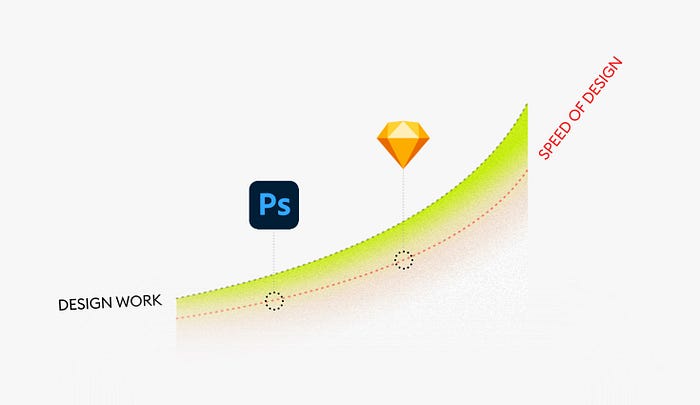
Taste IS the experience
Taste is about picking what looks and feels just right for a project. You can either pick it from outcomes, or within your imagination. In the latter case you create the outcomes, then pick the best ones.
It's about consciously choosing colors, photos, or designs that match the vibe or story you're trying to tell.
Good taste means knowing what will grab people's attention and make them feel something. It's a skill that grows with practice and seeing a lot of good design or art.
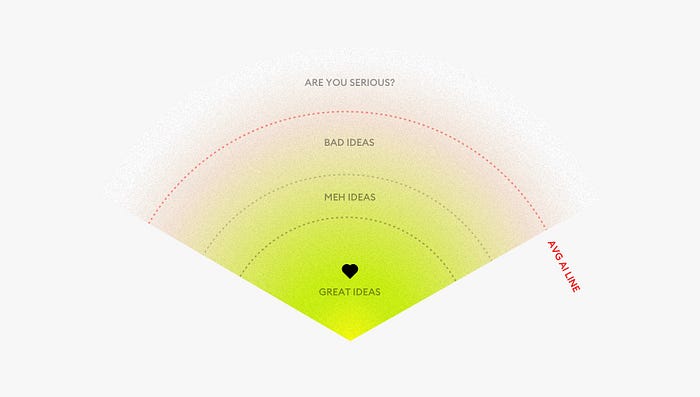 It's about separating the good from the hilariously bad
It's about separating the good from the hilariously bad
Can you learn taste?
Yes.
I am going to show you a couple of thought patterns I used to get from a mediocre designer to someone who can consciously take ownership of his design decisions.
I started designing in 1998, in the era of Photoshop. Everything was raster graphics back then and later Flash vector animations. But for many years I had good ideas, but not enough visual skills to develop them in a meaningful way.

In 2009 I left an agency job to start my own company. It was tough. Stressful. I was completely broke for the first two years. Low paying clients with extreme expectations and late payments were my daily bread.
I realised that I need to level up my skills fast, or I'll be stuck in that low paying limbo.

This is closer to reality now. If you believe your execution is higher than your ideas, check your ego.
Your brain is a database
It may not follow a traditional SQL structure, but it's a series of rows and columns with categories and elements assigned to them.
Which means enough of the right input can fill it with mostly good inspiration. That lead to good taste.
But how do you find good input? And without experience, how do you even know it's good?
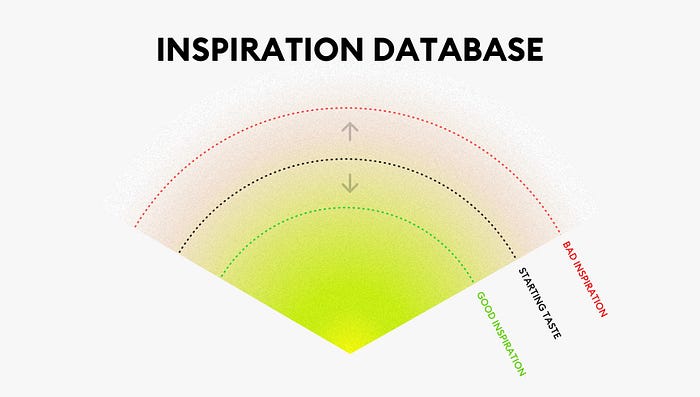
Not everyone starts at the same "basic" taste level. It heavily depends on our parents, first friends and environment we grew up in.
But depending on the inspiration you ingest the line can either move away from "good" or towards it.

My process of filling the database
Design in itself is a series of connected fields. UI design is not that far from industrial design, architecture or some parts of engineering.
You need to find people universally acknowledged as great. There aren't many with that status.
One example that comes to mind is Dieter Rams.

By looking at his work from the 50s and 60s, you can start noticing some patterns. Clean, minimalist, useful, yet strangely beautiful devices.
There is no ornamentation. Nothing unnecessary. But function does follow form. It's beautiful and useful. That is good design.
Even if you don't plan on designing record players, surround yourself with things like that. Taste gets acquired through exposure.

Some work from Yves Behar and Phillipe Starck is also worth checking out. Then of course we have Jony Ive. The list goes on.
Industrial design is generally easier to learn from than UI design because it's more mainstream. More people voted with their wallets to buy these beautiful objects.

Next column
Once you fill your industrial design column, you can start looking at interfaces. Take the biggest, most successful companies. Uber, AirBNB, Tesla are all examples of very well crafted interfaces.
All with their unique twists, without sacrificing the experience.
Cross reference ideas between the categories.
What does the AirBNB listing presentation screen have to do with a Braun SK-55 record player?

Reactionary
We can easily equate taste with experience. That makes total sense. But taste is also reactionary.
It reacts to market conditions. When a new trend emerges and takes over the public perception, designers adjust their "tastebuds" to include it.
Some, of course, will go against trends which is admirable, but embracing and modifying them is what most good designers do.
Even when the trend has limited capacities, like Neumorphism, it's still valuable to try it out. Make a couple of use cases for it. See when it works and when it doesn't.

It's exactly the same with Glassmorphism, albeit it became a lot more popular.
We often sacrifice readability and clarity for the sake of "looking cool". And that's ok too, sometimes.
You build your experience on the blocks from the past. On work from other great designers. But also on the real-time events of Today. What are people obsessed with right now?
Add it to your database. To your mix. See how it can be merged with other ideas.

It's a melting pot in your head
Experience mixed with creativity is a true superpower. Creativity often comes from being curious. The best designers are both creative and curious. They WANT to know what happens when you mix A and B together.
Even if, or especially if nobody has done that particular thing before.
Experiment!

Gaining experience
This process is ongoing. If you're curious, you'll keep adding things to your database. Keep forming opinions. Keep seeing overlaps between seemingly unrealted things.
This is how experience is forged. It's not always logical. Sometimes a vibe of a device can influence a screen design.
You can't rush experience, unless you upload someone else's database directly into your brain, Matrix style. But then it won't be your taste or your experience.
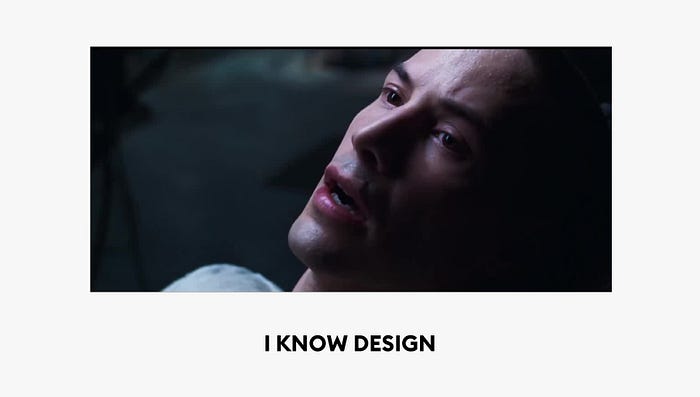
And if you ever want to charge clients good money, you can't re-sell taste. They pay for you, not for a copy.
That experience grows with time. It adjusts with changing landscapes. Let's look at my experience for a moment.
It was forged with pixellated 800x600 designs in Photoshop. Then the freedom of Sketch's vector graphics. Then prototyping, animation, some 3d. Now AI. My experience is a mix of all those things and more.
It's a uniquely personal process and it's the reason why people pay me for my work. Outcome of that work (a website design for example) is just one part of what the client pays for. And that outcome will become less and less valuable with time, as that part becomes faster and faster to do.
Value will be in the taste. In the personal take. In the illogical, emotional mental connections only a human can make. In the way you sell your services. In friendly chit-chat.

The eras of design tools
In User Interface design we had three full eras of design tools and are currently at the dawn of the fourth one.
It all started with text based inputs on the first computers. Interfaces were text based, on low resolution displays.

Then, with hypertext (HTML) introduction we started to see more visual approaches. Raster graphics, initially at low resolution, was created in tools like Photoshop.
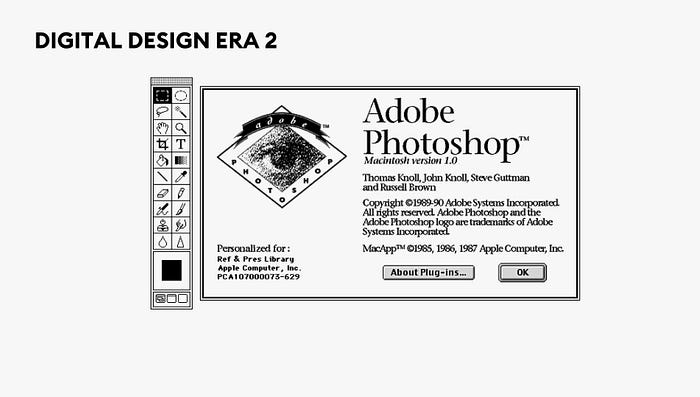
The next era came, when Adobe killed Macromedia Fireworks. An awesome vector graphics editor that was way ahead of it's time. That created a vacuum. Many designers knew how great of a tool that was, and vacuums are often short lived.
In 2010 Sketch officially came into existence and transformed design again into components (Symbols) and lightweight vector graphics. Figma later refined it and added even more features, but all within the same paradigm.

Now we're in the fourth era. There is some talk about pure Chatbot interfaces for many usecases, and people already are switching from traditional search engines to LLMs. But there's also the whole notion of generative AI for both photography, video, illustration, UI and code.
You can "vibe code" a working app, with a database by just using plain english to explain what you want. It is up to 100x faster than before to make stuff right now.

The future of design with AI
What people fear the most right now is that AI is going to replace them. If it can make good enough design (or code) in 100x less time, why would you keep a person at a company?
And that fear is completely logical. Companies will need LESS designers or developers to operate as normal.
But here two things can happen.
They can all operate as normal, or increase the output using AI. I believe the latter will be more long-term beneficial. As even if some companies do it, they will outpace those that will just stick to AI-driven status quo.
If they just replace their designers with AI, they'll stand still with innovation, features and growth. It will just be cheaper.

Taste for the future
We don't know what the future brings. Maybe we'll achieve AGI and we'll train our own design consciousness to "do" design for us. Or maybe it will have better things to do.
But no matter how a design is created, someone still has to mark it as "good". Someone has to evaluate it. Tweak it. Add the emotional connection. Add the human touch. Package it. Tell a story around it.
And most of all, understand every aspect of it.
Otherwise it will be just like vibe-coding. Fun to play with, but not usable long-term, creating design-debt. You can't be clueless on how things work.
Taste is the most important skill that you should be pursuing right now. All that AI hype is just faster outputs. You're still in charge.
What's Your Reaction?
 Like
0
Like
0
 Dislike
0
Dislike
0
 Love
0
Love
0
 Funny
0
Funny
0
 Angry
0
Angry
0
 Sad
0
Sad
0
 Wow
0
Wow
0


![[VIP] Unlimited Pass 2025.10.27](https://i.pinimg.com/1200x/d2/f8/2e/d2f82e903b9ca33b0f13704cc85a3d8a.jpg)
![[LS] ls.graphics Pass 2025.09.19](https://i.pinimg.com/1200x/8e/f0/03/8ef00307d549d517f08df6c1ab174a51.jpg)
![[PRO] Craftwork Pass 2025.06.11](https://i.pinimg.com/1200x/98/d2/f0/98d2f0169226b431f4727441ecc6aa06.jpg)





![[VIP] Payra: Payment & Finance UI Kit Design](https://i.pinimg.com/1200x/bc/f8/f1/bcf8f124325ec739b03a0dd0049352cc.jpg)
![[VIP] Bento Cards for Framer](https://i.pinimg.com/1200x/e6/51/cb/e651cb2496c2c2da2d278cc1a88e7edf.jpg)

![[VIP] Finto: Finance Website Framer Template](https://i.pinimg.com/1200x/49/3a/cf/493acf9320f31e29daf0232320bee9aa.jpg)


![[VIP] Timeless: Creative Agency Template](https://i.pinimg.com/1200x/3b/10/96/3b1096cd981e32f5b3dc381dc8fc0905.jpg)
![[VIP] Kael Donovan: Portfolio Coded Template](https://i.pinimg.com/1200x/73/4f/18/734f187684b2ed69f36e89603e26a59e.jpg)
![[VIP] ShadCnKit: UI Kit [Oct 2025]](https://i.pinimg.com/1200x/f6/1b/82/f61b82730374fcaf1f474d520af0153b.jpg)


![[VIP] Marketing & Business Plan Pitch Deck](https://i.pinimg.com/1200x/39/31/93/3931932db43734736c0ab52f20a79c47.jpg)
![[VIP] Flex Brand Guideline Template](https://i.pinimg.com/1200x/84/6d/fe/846dfe9c370ad42e95a51cc2a8753b79.jpg)








![[LS] Torn Sticker Mockups](https://i.pinimg.com/1200x/0d/28/22/0d282259270a96bbec73debfdedac4ff.jpg)
![[VIP] Arms: Apple Device Mockups](https://i.pinimg.com/1200x/91/11/a9/9111a91c48f6bc5ea0ff0ccf2cb53283.jpg)







![[VIP] Animation Bootcamp](https://i.pinimg.com/1200x/21/4e/26/214e262f2e2b026cd3af84987beae045.jpg)






![[VIP] Mastering the Logo Grid: Pro Lectures + Illustrator Templates v2.0](https://i.pinimg.com/1200x/e0/b2/6e/e0b26ee6fb14b652f78f67a0ab635b33.jpg)
![[VIP] React Three Fiber: The Ultimate Guide to 3D Web Development](https://i.pinimg.com/1200x/78/02/1f/78021ffdfc8113cc8caba5b2c563ead4.jpg)

![[VIP] Premiere for Motion Designers](https://i.pinimg.com/1200x/55/88/37/558837c7b7e41f56c133f0e56da2b3cd.jpg)
![[VIP] Ryan Hayward: Ultimate Framer Masterclass 3.0](https://i.pinimg.com/1200x/48/d6/3f/48d63f9723d7c49e6c34c182557c7431.jpg)



![[VIP] Whoooa! 156 vector Lottie animations](https://design.rip/uploads/cover/blog/whoooa-156-vector-animations.webp)




![[VIP] Design That Turns Visitors into Buyers](https://i.pinimg.com/1200x/16/65/5e/16655e614acb68273411ec518d8b44d3.jpg)
![[VIP] Imperavi: User Interface Typography [Oct 2025]](https://i.pinimg.com/1200x/d3/d0/94/d3d09450f4743ea55ca7b7960f244759.jpg)



![[VIP] Jaka Smid: GigaGrowth Bundle](https://design.rip/uploads/cover/blog/gigagrowth-bundle.webp)








